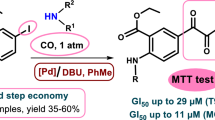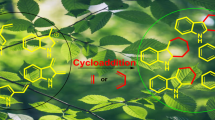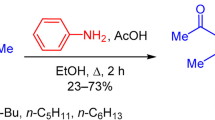Summary
The synthesis of 4-chloro-, bromo- and iodo- alizarins is described. Bromination of 2-O-p-toluene sulphonylalizarin (I) in glacial acetic acid gave a monobromo derivative (II), which on hydrolysis yielded a new bromoalizarin (III). Methylation of (III) gave the known 4-bromoalizarin-2-methyl ether, showing that (III) is 4-bromoalizarin. Chlorination of (I) with sulphuryl chloride in nitrobenzene gave 4-chloro-2-O-p-toluene-sulphonylalizarin (XII), which on hydrolysis yielded 4-chloroalizarin. Condensation of (II) and (XII) with aniline andp-toluidine led to 4-anilino-and 4-p-toluidinoalizarins. In addition to the 4-arylaminoalizarins, 1:2:4-trianilino and 1:2:4-tri-p-toluidinoanthraquinones were isolated by chromatography. Condensation of 4-nitroalizarin with aniline in presence of boric acid gave 4-anilinoalizarin, which was different from the product described by Gonsalves,et al., as 4-anilinoalizarin. 6:7-Dihydroxyanthraquinoneacridone was prepared from (II) in the usual manner and examined as a vat dye. 4-Iodoalizarin-2-methyl ether (XV) was prepared from alizarin-2-methyl ether by nitration, reduction, and replacement of the amino group by iodinevia the diazonium salt. Demethylation of (XV) with aluminium chloride gave 4-iodoalizarin.
Similar content being viewed by others
References
Ullmann and Conzetti..Ber., 1920,53, 826; Ullmann, D.R.P.282, 494.
Ullmann and Conzetti .. D.R.P., 158, 257.
Waldmann..J. prakt. Chem., 1938,150, 99.
Wedekind .. D.R.P., 189, 937.
Diehl..Ber., 1878,11, 187.
Gandbhir,et al...Curr. Sci., 1950,19, 380.
.. B.P., 120, 528 (cited from Ref. 12).
Mitter and Biswas..Ber., 1932,65, 622.
.. D.R.P., 117, 923.
Perkin ..J. Chem. Soc., 1874, 401.
-- and Haddock ..Ibid., 1933, 1512.
Barnett and Cook ..Ibid., 1922, 1376.
Dimroth, Schultze and Heinze..Ber., 1921,54, 3035.
Perkin and Story ..J. Chem. Soc., 1931, 2620.
Pratt and Archer..J. Am. Chem. Soc., 1949,71, 2938.
Seer and Karl..Monatsh, 1913,34, 631.
Epsteinet al...J. Am. Roentgenol, 1946,56, 202.
Cf. D.R.P., 151, 511 (1:2:4-trianilinoanthraquinone from purpurin)
Epsteinet al...J. Indian Chem. Soc., 1950,27, 479.
Cf. D.R.P., 150, 322.
Perkin and Storey ..J. Chem. Soc., 1928, 241.
Sen..J. Indian Chem. Soc., 1946,23, 383.
..Cf. D.R.P., 66, 811.
Author information
Authors and Affiliations
Rights and permissions
About this article
Cite this article
Joshi, B.S., Tilak, B.D. & Venkataraman, K. Anthraquinone and anthrone series. Proc. Indian Acad. Sci. (Math. Sci.) 34, 304 (1951). https://doi.org/10.1007/BF03172282
Received:
DOI: https://doi.org/10.1007/BF03172282




